Discover Florida Nature
It's time to explore the natural Florida


|
|
|
|
|
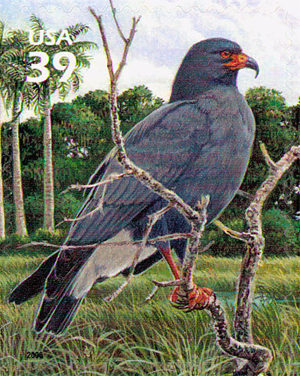 Snail
Kite
(Rostrhamus sociabilis plumbeus) Endangered- The Snail Kite has a body
length of 16 - 18 inches, nearly a 4-foot wingspan, and weighs 12 - 14
ounces. Snail Kites are found in tropical and subtropical lowland swamps
and marshes with scant vegetation in Florida, a few of the Caribbean
Islands, Central America, and South America. This kite’s beak is
specially adapted to extract aquatic snails from their shells. They will
also eat fresh water crabs, turtles, and small rodents if snails are not
available. Snail Kites hunt from a perch or by flying low over suitable
habitat looking for snails. This kite is one of the most specialized
feeders of any bird of prey. This specialty restricts the bird’s range
to marshy areas that contain specific types of snails. Snail
Kite
(Rostrhamus sociabilis plumbeus) Endangered- The Snail Kite has a body
length of 16 - 18 inches, nearly a 4-foot wingspan, and weighs 12 - 14
ounces. Snail Kites are found in tropical and subtropical lowland swamps
and marshes with scant vegetation in Florida, a few of the Caribbean
Islands, Central America, and South America. This kite’s beak is
specially adapted to extract aquatic snails from their shells. They will
also eat fresh water crabs, turtles, and small rodents if snails are not
available. Snail Kites hunt from a perch or by flying low over suitable
habitat looking for snails. This kite is one of the most specialized
feeders of any bird of prey. This specialty restricts the bird’s range
to marshy areas that contain specific types of snails.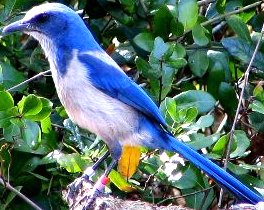 Florida
Scrub Jay
(Aphelocoma coerulescens) Threatened- A cousin of the scrub
jays common in the western United States and Mexico, the Florida scrub
jay is found only in the Sunshine State. These birds are about a foot
long from head to tail and mostly blue, like blue jays. They have a
light gray forehead and white throat. Their crestless head is blue, and
so are their wings and long, loose, tail feathers. Their beak and legs
are black, and their back and leg feathers are gray. Young ones, less
than 6 months old, have a brownish head and neck. Florida scrub jays
have a varied diet. Acorns are their favorite -- eaten all year long,
especially during winter when insects, their next favorite meal, are
scarce. They gather and bury thousands of acorns they can feed on any
time. They also prey on spiders and lizards, and young frogs, snakes and
mice. Florida
Scrub Jay
(Aphelocoma coerulescens) Threatened- A cousin of the scrub
jays common in the western United States and Mexico, the Florida scrub
jay is found only in the Sunshine State. These birds are about a foot
long from head to tail and mostly blue, like blue jays. They have a
light gray forehead and white throat. Their crestless head is blue, and
so are their wings and long, loose, tail feathers. Their beak and legs
are black, and their back and leg feathers are gray. Young ones, less
than 6 months old, have a brownish head and neck. Florida scrub jays
have a varied diet. Acorns are their favorite -- eaten all year long,
especially during winter when insects, their next favorite meal, are
scarce. They gather and bury thousands of acorns they can feed on any
time. They also prey on spiders and lizards, and young frogs, snakes and
mice.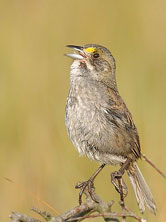 Cape
Sable Seaside Sparrow
(Ammodramus maritimus mirabilis) Endangered- Cape Sable seaside
sparrows are small birds about 5 inches long. Dorsally, they are dark
olive-gray with olive-brown on the tail and wings. Ventrally, adults
are light gray to almost white with dark olive-gray streaks on the
breast and sides. There is a dark whisker on either side of the white
throat. These sparrows have yellow lores, brown eyes, and a gray ear
patch behind the eye which is fringed by a dark line. There is a small
patch of yellow on the edge of the wing. No sexual differences in the
plumages are obvious. The Cape Sable seaside sparrow remains widely
distributed over a large area of south Florida and continues to occupy
much of its historically known range in Collier, Dade, and Monroe
Counties. Most of the sparrow population occurs in and near Taylor
Slough and in Big Cypress Swamp. The Cape Sable seaside sparrow inhabits
brushless, subtropical marshes (prairies) of interior southern Florida. Cape
Sable Seaside Sparrow
(Ammodramus maritimus mirabilis) Endangered- Cape Sable seaside
sparrows are small birds about 5 inches long. Dorsally, they are dark
olive-gray with olive-brown on the tail and wings. Ventrally, adults
are light gray to almost white with dark olive-gray streaks on the
breast and sides. There is a dark whisker on either side of the white
throat. These sparrows have yellow lores, brown eyes, and a gray ear
patch behind the eye which is fringed by a dark line. There is a small
patch of yellow on the edge of the wing. No sexual differences in the
plumages are obvious. The Cape Sable seaside sparrow remains widely
distributed over a large area of south Florida and continues to occupy
much of its historically known range in Collier, Dade, and Monroe
Counties. Most of the sparrow population occurs in and near Taylor
Slough and in Big Cypress Swamp. The Cape Sable seaside sparrow inhabits
brushless, subtropical marshes (prairies) of interior southern Florida.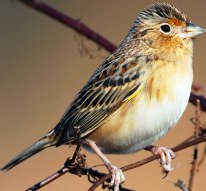 Florida
Grasshopper Sparrow
(Ammodramus savannarum floridanus) Endangered- Florida grasshopper
sparrows are small, short-tailed birds, about 5 inches long and weighing
less than one ounce. This not so drab sparrow is mostly black and gray
with some brown streaks on the back. Underneath, it is light gray or
buff color with no streaking. Feathers at the bend of the wing are
bright yellow and there is an orange patch in front of the eyes. A white
stripe marks the top of the head. The male’s primary song is weak and
grasshopper-like, giving rise to the bird’s common name. Florida
grasshopper sparrows are found in the prairies of south-central Florida
in Osceola, Polk, Highlands, and Okeechobee counties. Adult Florida
grasshopper sparrows are very sedentary, most occupying the same 4 -
acre territory for their entire life span of 2-3 years. Florida
grasshopper sparrows forage opportunistically as they skulk along the
ground and low in the grass. Adults eat grasshoppers, crickets, moths,
caterpillars, flies, and seeds of grasses and sedges. Florida
Grasshopper Sparrow
(Ammodramus savannarum floridanus) Endangered- Florida grasshopper
sparrows are small, short-tailed birds, about 5 inches long and weighing
less than one ounce. This not so drab sparrow is mostly black and gray
with some brown streaks on the back. Underneath, it is light gray or
buff color with no streaking. Feathers at the bend of the wing are
bright yellow and there is an orange patch in front of the eyes. A white
stripe marks the top of the head. The male’s primary song is weak and
grasshopper-like, giving rise to the bird’s common name. Florida
grasshopper sparrows are found in the prairies of south-central Florida
in Osceola, Polk, Highlands, and Okeechobee counties. Adult Florida
grasshopper sparrows are very sedentary, most occupying the same 4 -
acre territory for their entire life span of 2-3 years. Florida
grasshopper sparrows forage opportunistically as they skulk along the
ground and low in the grass. Adults eat grasshoppers, crickets, moths,
caterpillars, flies, and seeds of grasses and sedges.Scott’s Seaside Sparrow (Ammodramus maritimus peninsulae) SSC- Scott's Seaside Sparrow is a subspecies of the Seaside Sparrow. This bird is slightly smaller than a seaside sparrow and the back is marked with black and brownish green. Scott's seaside sparrow can be found along the Gulf of Mexico coast of northwestern Florida, where it breeds from Pasco County to Apalachee Bay and in the swamplands of St. George and St. Vincent islands. Scott's Seaside Sparrow and Wakulla Seaside Sparrow, which inhabit Gulf coastal marshes, are species of special concern. When mangroves overrun the grassy vegetation in these areas, the sparrows move on. (picture unavailable) Wakulla Seaside Sparrow (Ammodramus maritimus juncicolus) SSC- The Wakulla seaside sparrow is a subspecies of the seaside sparrow. The Wakulla seaside sparrow is only found in the Florida panhandle from southern Taylor county to Escambia bay. Like Scott's seaside sparrow it inhabits gulf marshes and is unable to stay in an area when mangroves overrun the grassy vegetation they need to survive. (picture unavailable) 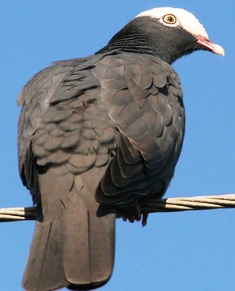 White-Crowned
Pigeon
(Columba leucocephala) Threatened- A resident of islands and
coastlines in the Caribbean, the White-crowned Pigeon reaches the
northern limits of its range in south Florida. It feeds almost entirely
on fruits of hardwood trees. This threatened bird is known for its
skittishness, but has become accustomed to humans in certain developed
areas where it is drawn to food sources. White-crowned Pigeons have a
particularly long nesting season in years when food is abundant, nesting
up to four times in a single year. White-Crowned
Pigeon
(Columba leucocephala) Threatened- A resident of islands and
coastlines in the Caribbean, the White-crowned Pigeon reaches the
northern limits of its range in south Florida. It feeds almost entirely
on fruits of hardwood trees. This threatened bird is known for its
skittishness, but has become accustomed to humans in certain developed
areas where it is drawn to food sources. White-crowned Pigeons have a
particularly long nesting season in years when food is abundant, nesting
up to four times in a single year.
|
|
|
Advertise | Privacy Statement | Dog Encyclopedia | Video |Contact | Alaska Nature |
|